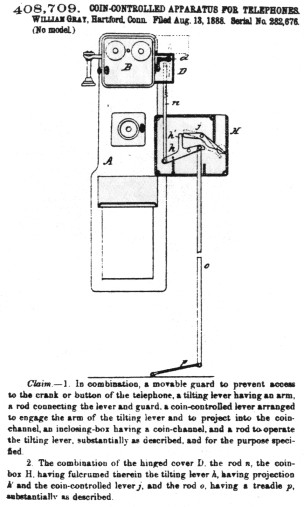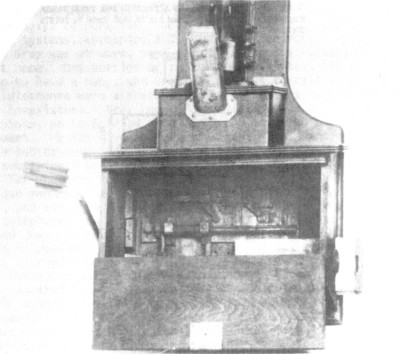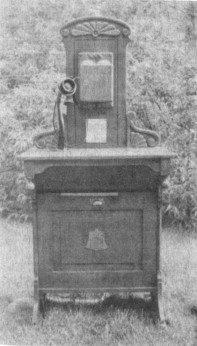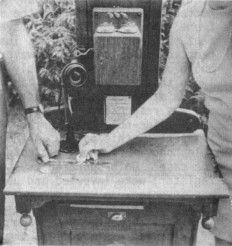Pioneer Pay Phones
by H. G. "Bea" Hyve
Reprinted from "INSULATORS - Crown Jewels of the Wire", August 1977, page 2
In today's world, coin-operated telephones are a carrion sight to almost
everyone. We can usually find one on every block, especially in heavily
populated areas. And because we are so used to them, we might tend to take them
for granted. But have you ever wondered just where the first coin-operated phone
originated, and under what circumstances? What did the very first one look like,
and when was it developed? And by whom?
It never occurred to me to ask such
questions until recently. I was reading a book called "Holladay Street" by
Max Miller and Fred Mazzulla when an interesting item came to light. This book
deals mainly with the street of that name in Denver, Colorado, which was the
"red light" district many years ago. As I read on, I came across a
statement concerning Laura Evans, a famous Colorado madame of that era. It said
that Laura had installed in her house in Salida (Colorado) what may have been
the country's first pay telephone. This naturally piqued my curiosity, so I
decided to ferret out more information about this telephone.
Laura came to
Salida in 1896 when she was about 34 years old. She established a business
there, and shortly thereafter found it necessary to have a pay telephone built
and installed in her "boarding house for young ladies". She already
had a regular phone in the house, but customers, just like the drunks of today,
would get "telephonitis" and run up bills of several hundred dollars each
month talking to friends in faraway places. Laura got tired of paying for
these unauthorized calls, so she spent eighteen hundred dollars and commissioned
the Gray Pay Station Telephone Company to build her a coin telephone. But before
we hear more about Laura's phone, it would be well to delve into the history of
pay phones in general for just a moment.
In that year of 1896 when Laura's phone
was built, coin-operated telephones were not a common sight and very few were
in existence. It had been just eight years earlier (in 1888) that William Gray
of Hartford, Connecticut, had perfected the idea of a coin telephone. There are
several stories as to how he came upon the idea, but a composite of all of them
goes something like this: Gray was foreman of the polishing department at the
Pratt and Whitney Company, a machine tool company in East Hartford. (Still in business under the name of United Technologies
Corporation, they now manufacture aircraft engines, systems, aerospace and
electrical products.) Apparently while Gray was at work, some sort of emergency
situation came up at home. One version of the story has it that his wife was
going to have a baby, and Gray was anxious to call a doctor. But telephones were
a scarce item in those days, and pay phones were nonexistent. Gray knew of an
office where there was a telephone, so he hurried over there and asked to use
the instrument. He was given a definite "no". Those who were telephone
subscribers in those days were very touchy about letting non-subscribers use
their telephones, and those wishing to use them for whatever reason were
generally turned away in a most brusque manner. Gray proceeded to explain the
urgency of the call, and was then very reluctantly given permission to use the
telephone. He offered to pay for the privilege, but was turned down, without
thanks. Instead, he was told that it was hoped he wouldn't make a practice of
using it, since such calls disrupted business.
Later, when Gray returned to
work, he began to think of some way that the general public would be able to get
telephone service if willing to pay for it. For weeks he worked on several crude
models, but they all proved unsatisfactory. So Gray confronted Amos Whitney, the
head of Pratt and Whitney Company, with his problem. Mr. Whitney had been
keeping his eye on a young apprentice pattern maker in the company who, despite
his youth, showed much promise and intelligence. So when Gray brought his
problem to Amos Whitney, he turned it right over to this young man, whose name
was George Alexander Long. Although he was only 16 at the time, George Long
constructed a workable model of the world's first coin-operated telephone. The
year was about 1887.
In 1888 William Gray filed his application for a patent on
his coin telephone, and exactly one year later, on August 13, 1889, he received
patent No. 408,709 for a"coin-controlled apparatus for telephones".
Gray's concept included a series of levers which, when activated by the
deposited coin, released a movable guard which then allowed "access to
the crank". This "apparatus" became the forerunner of a long line
of widely used and very successful public pay telephones. (See picture of patent
on page following.)
This same year (1889) the very first coin-operated pay
telephone was installed in Hartford. It was located on the ground floor, in the
banking rooms of the old Hartford Trust Company at Main Street and Central Row.
Although it was installed under the supervision of the Southern New England
Telephone Company, it was a Gray pay station. There had been two other pay
phones installed previously to this: one was a street pay station in front of a
cafe at Main Street and Mulberry, and the other in a cigar store at 859 Main
Street. However, these installations proved premature and were soon dismantled.
Consequently, the telephone in the old Hartford Trust Company is generally considered the very first "practical"
public coin-operated telephone anywhere in the world.
 |
Image text:
408,709. COIN-CONTROLLED APPARATUS FOR TELEPHONES. William
Gray, Hartford, Conn. Filed Aug. 13, 1888. Serial No. 282,676. (No model.)
Claim.-1. In combination, a movable guard to prevent acorn to the crank
or button of the telephone, a tilting lever having an arm. a rod connecting the
lever and guard. a coin-controlled lever arranged to engage the arm of the tilting
lever and to project into the coin- channel, an inclosing-box having a
coin-channel, and a rod to operate the tilting lever, substantially as described, and for the
purpose spcified.
2. The combination of the hinged cover
D. the rod n, the coin-box H. having fulcrumed therein the tilting lever A,
having projection h' and the coin-controlled lever j, and the rod o. having a
treadle p, substantially as described. |
It is thought that the
photo shown on the following page is the only one in existence of the original
coin-operated telephone. The front panel is open to show the inside workings
of the instrument. The details do not show up very well, but this is no doubt
where the movable guard and levers are that are spoken of in the patent
information. To the left is what is probably an arm rest, and the coin slot can
be seen at the top center of the photo. The metal plates on either side of the
coin slot appear to read "one dime".

The First Coin-operated Telephone
(Picture Courtesy Southern New England
Telephone Company)
Apparently the transmitter and
receiver had been removed by the time the photo was taken, or perhaps they are
out of the picture at the top. The light-colored rectangular object on the lower
right side of the phone is probably the coin box, which has been pulled out for the photo. Although information concerning the details of this
photo are sketchy, we can be glad that after so much time has passed, there is a
photo in existence of this pioneer pay phone.
Incidentally, the first
"coin-operated" telephone service should not be confused with the
first "pay station" service which began nine years earlier in 1880, where
the toll was given to an attendant. This prior attempt at pay telephone service
was expensive and made such service very limited and unprofitable, for the
intake barely paid the attendant's wages. "Coin-operated" telephone
service, as opposed to "pay station" service, required the deposit of
a coin, which then automatically gave the customer access to the telephone
instrument. However, today we have come to know "coin-operated"
services as "pay station" service, and these two terms are now
synonymous.
In 1891 Gray and two other men incorporated the Gray Pay Station
Telephone Company, later renamed the Gray Manufacturing Company. (Now called
the Gray Company, it is no longer in the business of manufacturing telephone
equipment.) In 1901 George Long joined "Gray Pay" and came up through
the ranks to the position of president and general manager by 1929. Mr. Long was
associated for a great many years with "Gray Pay", and was granted more patents on telephone toll apparatus than any other single
person--over 100 in number.
He traveled extensively throughout the United States
and Canada promoting the use of coin telephones in such places as hotels and
restaurants. He became the world authority on the subject of telephone toll
machines. Many of his innovations are still used today on pay telephone
equipment. To cite just a few, there is the three-slot coin collector familiar
to almost everyone, as it is used throughout the world on millions of pay
phones. He also was responsible for the compact type of telephone and pay
station as a single unit that we know today. And, he in- vented the "lock
of a million combinations", one of many baffling locks he devised to
protect the contents of coin boxes on pay telephones. George Long was a tireless
worker in the field of coin telephones and devoted many years to the furthering of their use in a skeptical world where the idea was so new.
It is
interesting to note that even the infant telephone industry was not at first
particularly fond of the idea of the pay station telephone. But it was this
invention that created a sudden, prolific source of income and enabled the
industry to forge ahead and become the huge success that it is today.
The
original Gray Pay Station Telephone Company was located at the back of 64 Asylum
Street in downtown Hartford. In this one-room factory Gray pay stations were
constructed and sent to even the most remote corners of the world as the orders
came in. The company usually rented out pay phones for 25 per cent of the take.
Ten per cent went to the place of business in which the phone was installed, and
65 per cent went to the telephone company to which the pay station was
connected.
At this point in the story we can return to Laura Evans' phone, for
it could have been under a similar arrangement that her telephone was installed,
excluding the 25 per cent to Gray's company, however, since Laura owned her
telephone outright. She probably didn't come out ahead financially in this
regard, though, as her phone required a special crew for maintenance; and
because the phone was her own property, she was responsible for all maintenance
fees.
A side-note that surfaced during my research may be of interest at this
point. Although one might think that pay telephones were the first coin-operated
devices, this is not the case. Coin-operated toys and an electric till (or cash
register) were invented and used long before the telephone was invented.
Laura's
telephone was certainly a unique piece of furniture. It consisted of a large
desk-like cabinet, constructed of yellowish oak wood. On the top was mounted a
metal stand which was long and slender and slightly curved, and this stand held
the mouthpiece, or transmitter. The bell-box was attached to a
beautifully-carved wooden back board, and the receiver hung on a hook on the
left side of this box. On the top of the cabinet were five slots for coins which
(from left to right) accepted silver dollars, fifty-cent pieces, quarters,
dimes, and nickels. The name "Gray" can be seen on the bell-shaped plate shown on the lower portion of the cabinet. The words written in the
square directly below the box read as follows:
|
DIRECTIONS
- - - - - - - - - - -
Call the Central Office in the usual way.
DO NOT DEPOSIT any money until told to do so by the operator.
The Telephone must be OFF THE HOOK when the money is deposited.
Be sure and drop money in the PROPER SLOT.
|
Laura kept the phone until just before her death in 1953, when she gave it to
Fred and Jo Mazzulla of Denver. It resides there today in their fabulous
collection of items related to early Colorado history. Telephone officials of
Denver have tried to buy this beautiful old phone from the Mazzullas, but they
are understandably reluctant to part with such a prize.

Laura's Phone |

Coin Slots |
(Pictures from Collection of Fred and Jo Mazzulla)
Laura's pay telephone was no doubt the first of its kind in Colorado and
probably all of the West; it was certainly one of the first in the nation. It
would not be an overstatement to say that this phone collected a sizable fortune
during the years of its use. It played a major role in the development of the
West, and can be considered a true pioneer in the field of early telephone
communications. It was created out of necessity, as so many innovations are, and
survives today as a beautiful piece of telephone history: a legacy from a most
colorful lady--for all present and future lovers of early Telephoniana to enjoy.
And as for Gray's invention and Long's perfection of the idea, copies of these
pioneer telephone pay stations can be found in the Smithsonian Institution in
Washington, D. C. To both Laura's pay phone and Gray's first coin-operated phone
we owe a large debt of gratitude, for their early years of service were
instrumental in bringing us the convenience of the pay telephones we know today.
- - - - - - - - - - - -
I am especially indebted to Mr. Fred Mazzulla for his assistance in providing
additional information for my story, for kindly giving me permission to use
material from his book "Holladay Street", and for loaning me the
outstanding photos of Laura Evans' telephone. I would also like to thank L. F.
Marley of Western Electric in Denver for sending me much needed information
about the Gray Company. Thanks also to Mrs. Clara M. Melia of the Southern New
England Telephone Company in New Haven, Connecticut, for providing information
on the first pay telephone in Hartford, also information on George Long, and for
the invaluable photo of the first pay phone. These three people were most
generous with their time and knowledge. I have also taken information from the
following sources: "Famous First Facts" by Joseph Nathan Kane,
"Events in Telephone History" by the American Telephone and Telegraph
Company, and Courant Magazine, January 26, 1958.
|
